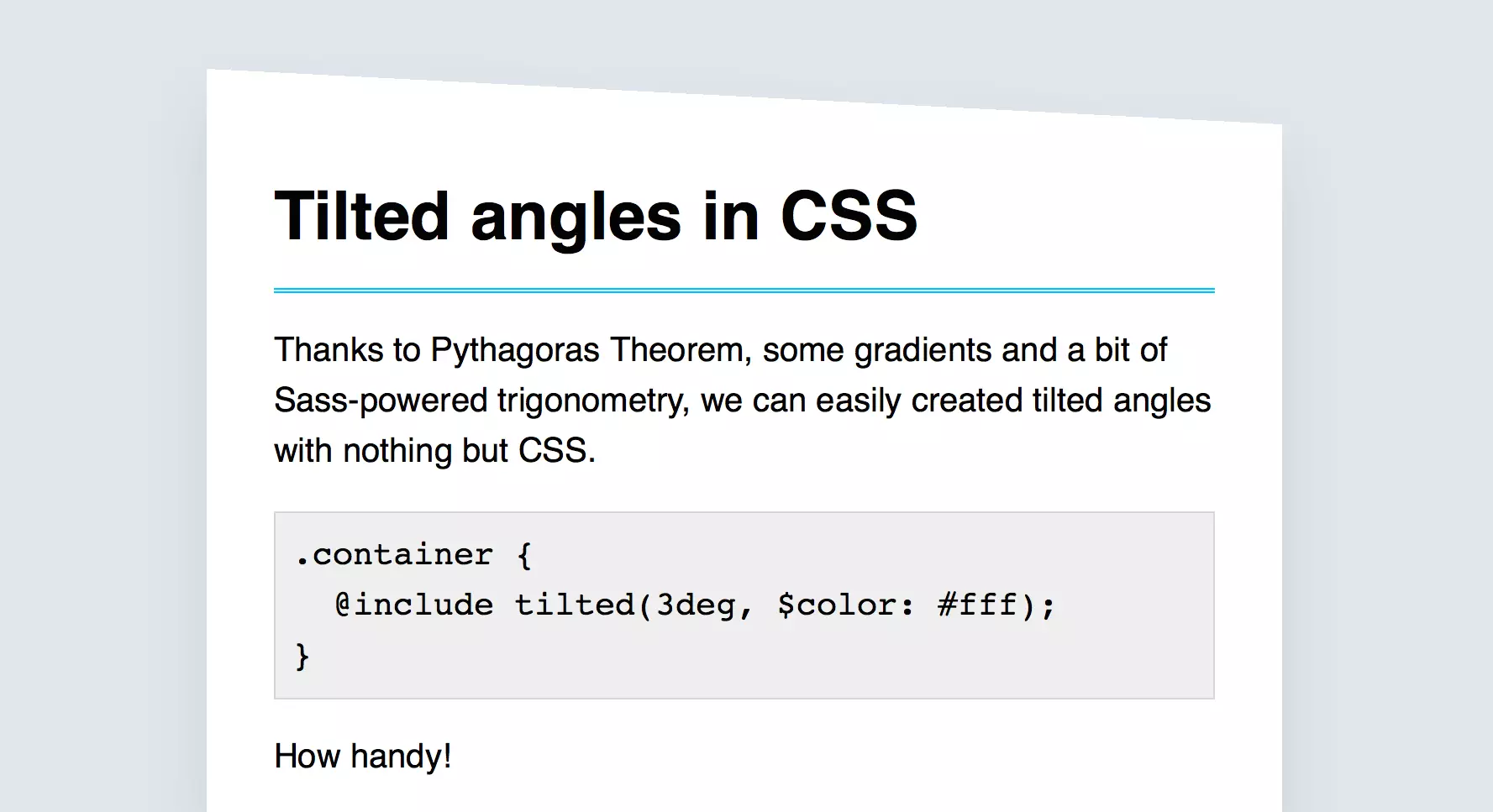Tilted Angles in Sass
This article explores creating tilted angles in CSS using Sass, offering a sophisticated solution that avoids the limitations of other methods. Instead of using base64 encoded images, skewed pseudo-elements, or the Angled Edges library, this approach leverages a clever gradient technique.

Traditional methods like base64 images hinder customization, while skewing is cumbersome, and the Angled Edges library requires fixed dimensions. This new method uses a half-transparent, half-solid linear gradient applied to an absolutely positioned pseudo-element. The gradient's angle dictates the tilt.

A Sass mixin encapsulates this, accepting the angle and color as parameters. The key challenge lies in dynamically calculating the pseudo-element's height based on the angle. This is solved using trigonometry and the Pythagorean theorem.

A Sass function, get-tilted-height(), performs this calculation. It uses the sine function and the Pythagorean theorem (b = √(c² - a²)) to determine the height (b) based on the angle (B) and a width of 100%.
The tilted() mixin then applies the calculated height (via padding-top) to the pseudo-element, along with the gradient and color styling. The container element receives the background color for consistency. The mixin uses position: relative on the container to establish the positioning context for the pseudo-element.
While this method is more complex than others, it offers greater flexibility and avoids the drawbacks of simpler approaches. The article concludes by suggesting potential improvements, such as handling existing ::before pseudo-elements and allowing bottom tilting. The author also notes that using JavaScript-based Sass functions (via Eyeglass or Sassport) could enhance the solution.
Frequently Asked Questions (FAQs) about Tilted Angles in Sass (Summarized):
The FAQs section provides explanations on using Sass's sqrt function for angle calculations, the purpose of tilted angles in Sass, the availability of other mathematical functions, string-to-number conversion, common uses of sqrt, creating diagonal lines and circles using sqrt, using sqrt with variables, and the function's syntax and combination with other functions. These are all answered concisely within the original text.
The above is the detailed content of Tilted Angles in Sass. For more information, please follow other related articles on the PHP Chinese website!

Hot AI Tools

Undresser.AI Undress
AI-powered app for creating realistic nude photos

AI Clothes Remover
Online AI tool for removing clothes from photos.

Undress AI Tool
Undress images for free

Clothoff.io
AI clothes remover

Video Face Swap
Swap faces in any video effortlessly with our completely free AI face swap tool!

Hot Article

Hot Tools

Notepad++7.3.1
Easy-to-use and free code editor

SublimeText3 Chinese version
Chinese version, very easy to use

Zend Studio 13.0.1
Powerful PHP integrated development environment

Dreamweaver CS6
Visual web development tools

SublimeText3 Mac version
God-level code editing software (SublimeText3)

Hot Topics
 1655
1655
 14
14
 1413
1413
 52
52
 1306
1306
 25
25
 1252
1252
 29
29
 1226
1226
 24
24
 Google Fonts Variable Fonts
Apr 09, 2025 am 10:42 AM
Google Fonts Variable Fonts
Apr 09, 2025 am 10:42 AM
I see Google Fonts rolled out a new design (Tweet). Compared to the last big redesign, this feels much more iterative. I can barely tell the difference
 How to Create an Animated Countdown Timer With HTML, CSS and JavaScript
Apr 11, 2025 am 11:29 AM
How to Create an Animated Countdown Timer With HTML, CSS and JavaScript
Apr 11, 2025 am 11:29 AM
Have you ever needed a countdown timer on a project? For something like that, it might be natural to reach for a plugin, but it’s actually a lot more
 HTML Data Attributes Guide
Apr 11, 2025 am 11:50 AM
HTML Data Attributes Guide
Apr 11, 2025 am 11:50 AM
Everything you ever wanted to know about data attributes in HTML, CSS, and JavaScript.
 How to select a child element with the first class name item through CSS?
Apr 05, 2025 pm 11:24 PM
How to select a child element with the first class name item through CSS?
Apr 05, 2025 pm 11:24 PM
When the number of elements is not fixed, how to select the first child element of the specified class name through CSS. When processing HTML structure, you often encounter different elements...
 Why are the purple slashed areas in the Flex layout mistakenly considered 'overflow space'?
Apr 05, 2025 pm 05:51 PM
Why are the purple slashed areas in the Flex layout mistakenly considered 'overflow space'?
Apr 05, 2025 pm 05:51 PM
Questions about purple slash areas in Flex layouts When using Flex layouts, you may encounter some confusing phenomena, such as in the developer tools (d...
 A Proof of Concept for Making Sass Faster
Apr 16, 2025 am 10:38 AM
A Proof of Concept for Making Sass Faster
Apr 16, 2025 am 10:38 AM
At the start of a new project, Sass compilation happens in the blink of an eye. This feels great, especially when it’s paired with Browsersync, which reloads
 In front-end development, how to use CSS and JavaScript to achieve searchlight effects similar to Windows 10 settings interface?
Apr 05, 2025 pm 10:21 PM
In front-end development, how to use CSS and JavaScript to achieve searchlight effects similar to Windows 10 settings interface?
Apr 05, 2025 pm 10:21 PM
How to implement Windows-like in front-end development...
 How We Created a Static Site That Generates Tartan Patterns in SVG
Apr 09, 2025 am 11:29 AM
How We Created a Static Site That Generates Tartan Patterns in SVG
Apr 09, 2025 am 11:29 AM
Tartan is a patterned cloth that’s typically associated with Scotland, particularly their fashionable kilts. On tartanify.com, we gathered over 5,000 tartan




